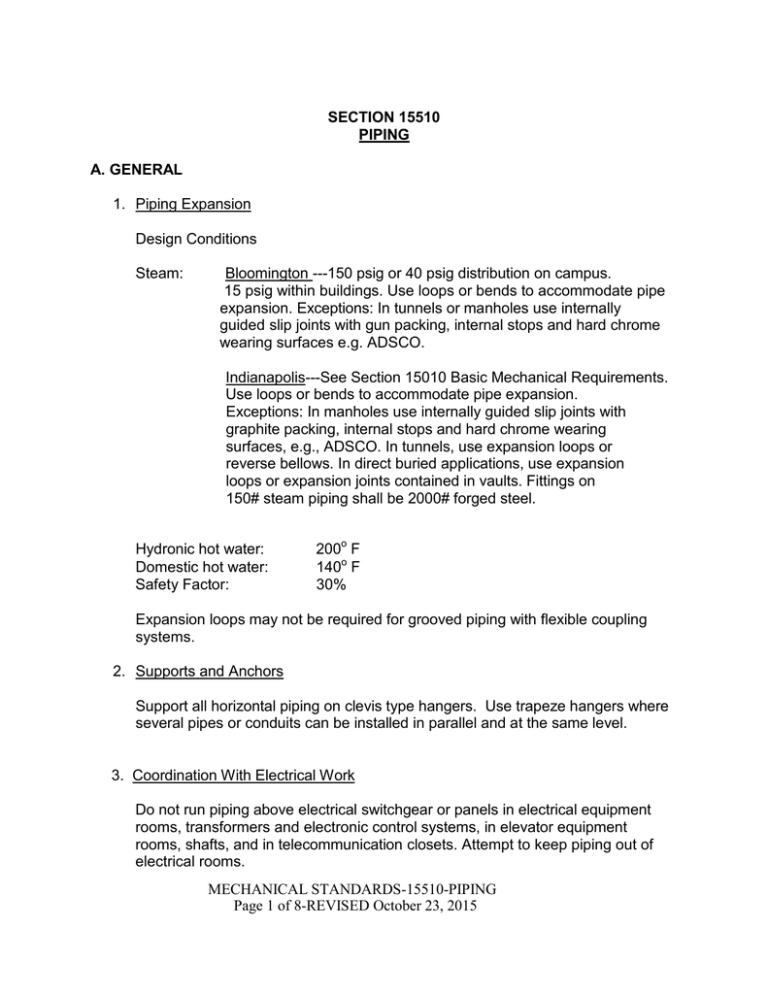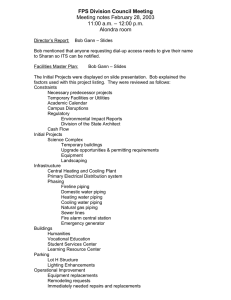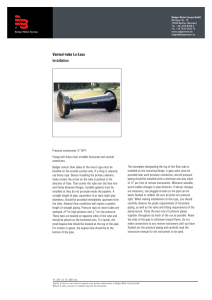MECHANICAL STANDARDS-15510-PIPING
advertisement

SECTION 15510 PIPING A. GENERAL 1. Piping Expansion Design Conditions Steam: Bloomington ---150 psig or 40 psig distribution on campus. 15 psig within buildings. Use loops or bends to accommodate pipe expansion. Exceptions: In tunnels or manholes use internally guided slip joints with gun packing, internal stops and hard chrome wearing surfaces e.g. ADSCO. Indianapolis---See Section 15010 Basic Mechanical Requirements. Use loops or bends to accommodate pipe expansion. Exceptions: In manholes use internally guided slip joints with graphite packing, internal stops and hard chrome wearing surfaces, e.g., ADSCO. In tunnels, use expansion loops or reverse bellows. In direct buried applications, use expansion loops or expansion joints contained in vaults. Fittings on 150# steam piping shall be 2000# forged steel. Hydronic hot water: Domestic hot water: Safety Factor: 200o F 140o F 30% Expansion loops may not be required for grooved piping with flexible coupling systems. 2. Supports and Anchors Support all horizontal piping on clevis type hangers. Use trapeze hangers where several pipes or conduits can be installed in parallel and at the same level. 3. Coordination With Electrical Work Do not run piping above electrical switchgear or panels in electrical equipment rooms, transformers and electronic control systems, in elevator equipment rooms, shafts, and in telecommunication closets. Attempt to keep piping out of electrical rooms. MECHANICAL STANDARDS-15510-PIPING Page 1 of 8-REVISED October 23, 2015 4. Burial Depth In general, bury all underground piping at least 3 feet below finished grade; observe local frost depths; install metallic locator tape. See Section 15010. 5. Painting At IUPUI all interior piping shall be labeled and painted per ANSI Standard. 6. Pressure Testing Test all piping at minimum 1-1/2 times the operating pressure. The duration of test shall be minimum of four (4) hours. B. DOMESTIC WATER PIPING 1. Interior Cold water Hot Water 2. In slab or underground Less than 4 inches <= 4 inches > 4 inches Copper tubing Type L Galvanized steel or Copper tubing Type L All sizes Copper tubing Type L Copper tubing Type K 4” – 12 inches Ductile iron, Class 350 cement lined Larger than 12” Consult with IU Engineering Services 3. Underground building main shut-off valves shall be clockwise to close and counter-clockwise to open. C. SEWER PIPING/SOIL AND WASTE PIPING/STORM WATER PIPING 1. Above ground, interior pipe Cast iron XH soil pipe, no hub, except for swimming pools use PVC. 2. Underground, under building Cast iron XH soil pipe with a heavy coating of coal tar varnish or asphaltum on both inside and outside surfaces. MECHANICAL STANDARDS-15510-PIPING Page 2 of 8-REVISED October 23, 2015 3. Underground, outside buildings a. Sanitary PVC, SDR35 with push on joints. b. Storm Reinforced Concrete Pipe or Polyethylene At IUPUI: Reference the latest City of Indianapolis Department of Public Works Indianapolis Sanitary District Standards Manual for acceptable manufacturers, design and permit requirements. 4. Manholes Bloomington and Regional Campuses: Precast concrete sections Indianapolis: a. Stormwater Quality Unit (SQU) or Best Management Practice (BMP) type manholes shall be installed and sized to treat all storm flow prior to discharge to the public utility sewer in accordance with Phase I Stormwater regulations. b. An O&M manual for the unit shall be submitted to the City of Indianapolis as part of the Operating Permit for the SQU and storm sewer use. The permit application shall be reviewed by IUPUI CFS Engineering prior to signature by the IUPUI Vice Chancellor and permit application submittal. c. Reference the latest City of Indianapolis Stormwater Design and Construction Specifications Manual for acceptable manufacturers, design and permit requirements. d. All storm sewer manhole lids, curb inlets, storm drains or catch basins covers or grates shall have an environmental warning, similar to “ Do Not Dump – Leads to Stream” including fish outline or similar symbol, cast integral with the assembly. 5. Dye test all waste lines installed during renovation of existing buildings to ensure waste will not enter storm water system. 6. Provide drain from swimming pool and outdoor fountains to sanitary drain. 7. Do not use double sanitary tee fitting. Use Wye fitting with 1/8 bends. MECHANICAL STANDARDS-15510-PIPING Page 3 of 8-REVISED October 23, 2015 D. LABORATORY OR ACID WASTE AND VENT PIPING 1. Interior Flame retardant Polypropylene (ASTM D4101) or glass. For polypropylene use mechanical joints for 2” and less. Use fused seal joints for 2 ½” and larger pipes. Use glass in return air plenums. E. NATURAL GAS PIPING 1. Building Distribution Piping Black steel, schedule 40 2. Pipe in Ground Polyethylene or fusion bonded epoxy coated black steel 3. Evaluate the building gas pressure against the minimum required by gas fired equipment. Provide appropriate gas regulator if required. Do not locate any gas shut-off valve in a return air plenum or an inaccessible area. F. COMPRESSED AIR 1. Interior Copper tubing Type L up to 125 psig. Copper tubing type K for over 125 psig. Brazed joints. 2. Provide appropriate pressure regulator. G. MEDICAL GAS/BOTTLED GAS 1. Cylinder gases (Not chlorine). with Swagelok fittings. Stainless steel 304L or 316L tubing 2. Medical Oxygen, Medical Air, Vacuum Copper tubing Type K H. FUEL OIL PIPING 1. Underground Double pipe system. Install leak detection system for the piping. 2. Interior Double Wall Construction Black steel installed in compliance with MECHANICAL STANDARDS-15510-PIPING Page 4 of 8-REVISED October 23, 2015 the latest requirements of the Indiana State Fire Marshal. I. FUEL STORAGE TANKS 1. Aboveground (preferred) Steel, welded tank. Comply with the latest requirements of the Indiana State Fire Marshal. 2. Underground FRP fiberglass tanks, double walled. Tank and installation shall have spill and overfill protection, and be equipped with leak detection per IDEM guidelines. At IUPUI: Avoid the installation of underground storage tanks. J. HYDRONIC PIPING 1. Interior <= 2" 2-1/2” to 4” > 4" Copper tubing Type L. Copper tubing Type L or welded Sch 40 black steel Sch 40 welded black steel IUPUI: Above grade chilled water piping, flanges, and fittings to be Class 150 or greater. 2. Underground (chilled water only) Pre-insulated, ductile iron, cement lined pipe and PVC jacket and mechanical fittings. 1-1/2” thickness polyurethane insulation. At IUPUI, contact C.T.E. for current piping, fitting and testing specifications. IUPUI: CTE shall provide design drawings, specifications and test requirements. Exterior, underground chilled water piping shall be cement lined ductile iron pipe, Class 250 or greater, field lock gaskets, and Class 350 ductile iron fittings. 3. Condensate Drain Copper Type DWV or Type L copper. 4. Install bypass type chemical feeder across pump. MECHANICAL STANDARDS-15510-PIPING Page 5 of 8-REVISED October 23, 2015 5. Design system for air elimination with one heavy duty automatic vent at point of lowest solubility. Provide air separator without strainer at pump suction. Provide 3/8" ball valves at risers to allow system fill. Provide automatic vent, piped to drain, on top of air separator. Automatic air elimination system is not required for chilled water systems utilizing campus chilled water. 6. Provide bladder type expansion tank to allow for water expansion on pump suction side. 7. Chilled Water System Design Using Campus Chilled Water Drawings titled “Standard Piping Connection for Central Chilled Water” (Bloomington and regional campuses) and “Chilled Water Piping Connection for Primary/Secondary Loop at IUPUI” show standard designs for campus building connection to the central chilled water loop. The drawings are attached at the end of this section. Use 42oF EWT and select all chilled water coils for 13o temperature differential for Bloomington and the regional campuses. Consult with Campus Facility Services for chilled water supply temperatures at IUPUI. Standing over buried chilled water pipes with your back to the central chilled water plant the supply pipe is on your right and the return pipe is on your left. Install new pipes to match. Note: This rule does not apply to IUPUI. 8. Chilled Water System Design Utilizing Building Chiller Provide primary, secondary pumping schemes. Each chiller shall have its own constant speed pump. Provide two secondary variable speed pumps—verify for each project if secondary pumps are to be sized for 50% or 100% flow each. Use variable frequency drives for secondary pumps. Provide remote differential pressure controller to vary secondary pump speed. 9. Heating Water System Design The heat source shall be steam from the central heating plant, (Bloomington), utility provider to the Campus system (IUPUI), or a gas fired hot water boiler. Provide shell and tube type steam to water heat exchanger when campus steam is utilized. 10. Hydronic Systems Design Hydronic systems should be designed for a general range of pipe friction loss between 1 and 4ft/100 ft. Flow velocities in water pipes should not exceed 8 fps (4 fps for 2 in. pipe and smaller). Minimum velocity should be 2 fps. Piping shall be a minimum size of ¾ in. Nominal pipe size or, in essence, pipe I.D. shall be MECHANICAL STANDARDS-15510-PIPING Page 6 of 8-REVISED October 23, 2015 used to select and specify piping in the contract documents. K. STEAM PIPING 1. Interior <= > 2” 2. Underground 2” Schedule 40, black steel, threaded Schedule 40, black steel, welded. Pre-insulated Schedule 40 black steel pipe. Provide epoxy coated steel jacket. Welded joints. 3. IUB: Reduce steam pressure to 15 psig inside the building. IUPUI: If on tunnel distribution system, reduce steam pressure to 10 psig inside the building. High pressure piping (250# or 150 # on Main campus) shall be designed to withstand temperatures of 600º F. In general, this requires Class 300 weld-in valves, 2000# forged steel fittings, and Best-O-Bell traps. Medium (50#) and low pressure (10#) systems shall use Class150 valves, 2000# forged steel fittings and Best-O-Bell traps. Flanged connections on medium pressure steam, and if approved on high pressure, shall use Grade B7 bolts, ASTM A-193, with heavy hexagonal nuts, ASTM A-194 Grade 2H. Gaskets shall be spiral wound non- asbestos material for all flanged connections; no paper gaskets. Piping material spec shall be ASTM A-106 Gr B Schedule 40 for steam supply. Underground piping shall use closed-cell foam insulation like Pittsburgh Corning FoamGlas with PittWrap heat-sealed jacket. Insulation in vaults to be metal jacketed fiberglass. In general, 150 psig supply piping shall be seal welded, including valves and fittings. Isolation valves shall be installed inside and outside the building. Valves outside may not be direct buried, but accessible inside vaults. 4. Route discharge from safety relief valve directly to outdoor. L. STEAM CONDENSATE, PUMPED CONDENSATE PIPING < 2” > 2” 1. Interior 2. Underground Schedule 80, black steel, threaded. Schedule 80, black steel, welded. Pre-insulated schedule 80, black steel pipe. 3. Collect all condensate in each building and pump into the central steam condensate system for return to the central heating plant. At IUPUI all condensate is collected within buildings and cooled to 140oF or less before being discharged into the sanitary sewer system. MECHANICAL STANDARDS-15510-PIPING Page 7 of 8-REVISED October 23, 2015 4. Remove condensate by gravity from trap of all steam devices. Avoid condensate lift from steam devices. IUPUI: Steam chemical treatment shall be incorporated into building steam piping systems to prevent condensate piping corrosion for buildings fed directly from CTE. Treatment systems shall be automatic and complete including pump, injection quill, chemical storage and containment, sampling coolers, test coupon racks, and test equipment. M. DISTILLED WATER PIPING 1. Interior Schedule 80 virgin Polypropylene with fuse seal N. VACUUM PIPING 1. Interior Copper type L – brazed joints






